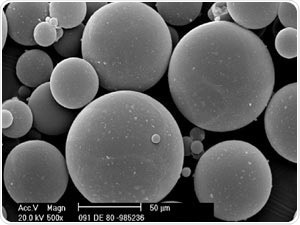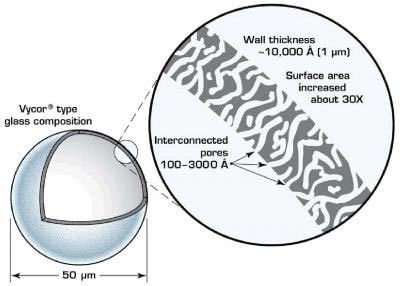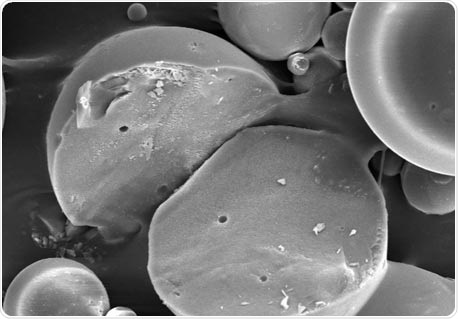Sponsored Content by Mo-SciNov 21 2016
Finding ways to improve efficiency and bioavailability is key to targeted drug delivery. Although controlled release dosage medication forms are the standard, they can have certain limitations.
One downside is the challenge in finding and retaining the drug delivery system in the gastrointestinal (GI) tract because of gastric emptying variation.1 This limitation can result in drug release that is insufficient for patients or lead to shorter residence time of the dosage in the stomach.
Hollow microspheres
To improve drug absorption and increase gastric retention, hollow microspheres have been designed and applied in the clinical setup for certain patients.2

Image credit: Mo-Sci
The materials used for the production of porous-wall hollow glass microspheres used in medicine include: silicates, bioactive glasses, ceramics, and biopolymers. Hollow microspheres have 10 to 100 micron-diameter hollow cavities, which are for the containment of certain substances.3

Image credit: Mo-Sci
Oral route is the most widely used mode for administering drugs to the systemic circulation. However, this route may not be suitable for some drugs due to their difficulty being absorbed through the GI tract. Therefore, professionals are looking for alternative approaches for delivering pharmacologically active substances to the body.
The hollow or porous features of microspheres enable them to encapsulate fragile drugs, thereby protecting them from biological compounds that may be interfering with drug availability.4
These spherical, empty particles can increase the residence time of drugs in the GI tract as they can stay unaffected in the gastric region for extended periods of time. Porosity not only improves loading efficiency, but also controls the release of drugs. In summary, hollow microspheres reduce drug waste by improving the bioavailability of a drug.

Image credit: Mo-Sci
It is possible to produce uniformly shaped and sized microspheres in order to improve their delivery to a specific target site. Moreover, microspheres can serve as an efficient carrier of therapeutic agents owing to their volume, large surface area and porosity.
In addition, they can be buoyant as they have a very low density because of their hollow center. This characteristic makes hollow microspheres a potential candidate for use in a myriad of applications.
Advantages of porous glass microspheres
Hollow microspheres facilitate improved patient compliance as they can lower dosing frequency. In addition, using microsphere, it is possible to maintain a desirable plasma concentration of a therapeutic agent through continuous drug release.
Gastric retention time can also be increased depending on the structure of the microspheres, thereby allowing therapeutic agents to be released for a longer time. Other benefits of using hollow microspheres in targeted drug delivery include:
- A better therapeutic effect can be achieved owing to short half-life drugs
- Gastric irritation can be avoided because of sustained release effect
- Site-specific drug delivery to the stomach
Limitations of porous glass microspheres
Patients have to consume a large amount of water in order to make the hollow microspheres float and function. Instead of merely consuming a sip of water with a drug as in the case of the typical oral route of drug administration, patients need to drink a full glass of water (200 to 250 ml) with the microsphere. Also, hollow microspheres are not suitable for drugs that have solubility and stability issues in gastric fluids.
Savannah River National Lab (SRNL) and Mo-Sci microspheres
The SRNL in collaboration with Mo-Sci, a company involved in the manufacture of specialty glasses, has created porous wall, hollow glass microspheres featuring glass “microballoons” with a diameter smaller than a strand of human hair.
SRNL’s microspheres have a unique network of interconnected pores in their walls. These pores allow the filling of tiny “microballoons” with gases as well as other materials.
Each SRNL microsphere is approximately 50µm in diameter, with a wall thickness of 10,000Å. The pores featured on their walls are about 100-300Å, allowing gases to entire the microspheres and be stored or cycled on absorbents.
SRNL’s microspheres were originally developed for providing a solid-state storage method for hydrogen. However, further research has shown the powerful utility and practical application of these microspheres in medicine.
At present, Mo-Sci aims to offer SRNL’s porous-walled hollow glass microspheres as a carrier for targeted drug delivery, among other applications.
Further research on microspheres is being carried out in an effort to identify new applications within healthcare. While microspheres are being further studied, they hold the potential to provide improved patient care and enhance the efficacy of medication delivery across a wide variety of disease states.
References
- Kurrey A, Suresh PK, Singh MR. Hollow microspheres as a drug carrier: An overview of fabrication and in vivo characterization techniques. Chronicles of Young Scientists. 2014;5(1):1-10.
- Qing W, Wenhai H, Deping W. Preparation of hollow porous HAP microspheres as drug delivery vehicles. Journal of Wuhan University of Technology-Mater. Sci. 2007;22(1):174177.
- Hossain KMZ, Patel U, Ahmed I. Development of microspheres for biomedical applications: a review. Progress in Biomaterials. 2015;4(1):1-19.
- Li S, Nguyen L, Xiong H. Porous-wall hollow glass microspheres as novel potential nanocarriers for biomedical applications. Nanomedicine. 2010;6(1):127–136.
- Wicks GG, Heung LK and Schumacher RF. Microspheres and Microworlds. American Ceramic Society Bulletin, Vol. 87, No. 6
- http://www.mo-sci.com/porous-silica/
About Mo-Sci

Mo-Sci, a world leader in precision glass technology, explores and develops new and exciting ways for their products and services to integrate within a wide variety of useful applications.
Mo-Sci has become a world leader in the research, development and manufacturing of glasses for specialty applications.
Sponsored Content Policy: News-Medical.net publishes articles and related content that may be derived from sources where we have existing commercial relationships, provided such content adds value to the core editorial ethos of News-Medical.Net which is to educate and inform site visitors interested in medical research, science, medical devices and treatments.